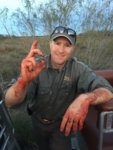I am a little late to be getting into this thread.
I took an Idaho Whitetail this year and it was my first time using a Barnes. I have a Tikka 270 and I loaded the 110g TTSX with Hunter powder by Ramshot with a muzzle velocity of 3420 fps. I hit the deer just behind the shoulder but a little bit high at 118 yards. The buck never took a step and a small cloud of hair/fur was still floating in the air for a few seconds after the shot. It was a complete pass through with an exit would of about 2 inches. I felt pretty over gunned. Massive damage to internal organs but very little meat damage.
Not saying I will always feel this way, but right now I am not interested in using anything else than Barnes for big game. I have ordered a box of 129g LRX that I am going to try in my 270. I have a good load worked up in my 243 using the 85g TSX at 3210 FPS. This spring I will begin load development on the 100g TTSX for my 257 Wby and the 130g TTSX for a lite weight 308 I have.
I took an Idaho Whitetail this year and it was my first time using a Barnes. I have a Tikka 270 and I loaded the 110g TTSX with Hunter powder by Ramshot with a muzzle velocity of 3420 fps. I hit the deer just behind the shoulder but a little bit high at 118 yards. The buck never took a step and a small cloud of hair/fur was still floating in the air for a few seconds after the shot. It was a complete pass through with an exit would of about 2 inches. I felt pretty over gunned. Massive damage to internal organs but very little meat damage.
Not saying I will always feel this way, but right now I am not interested in using anything else than Barnes for big game. I have ordered a box of 129g LRX that I am going to try in my 270. I have a good load worked up in my 243 using the 85g TSX at 3210 FPS. This spring I will begin load development on the 100g TTSX for my 257 Wby and the 130g TTSX for a lite weight 308 I have.


